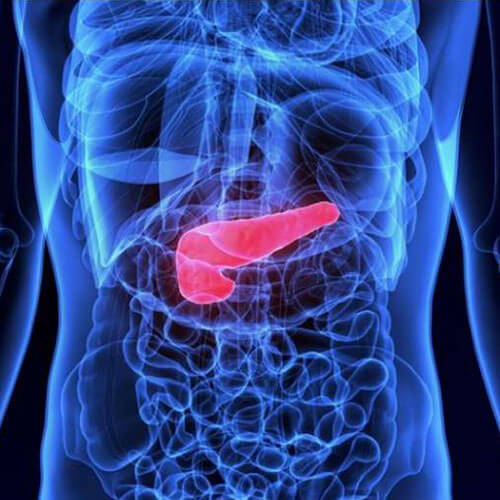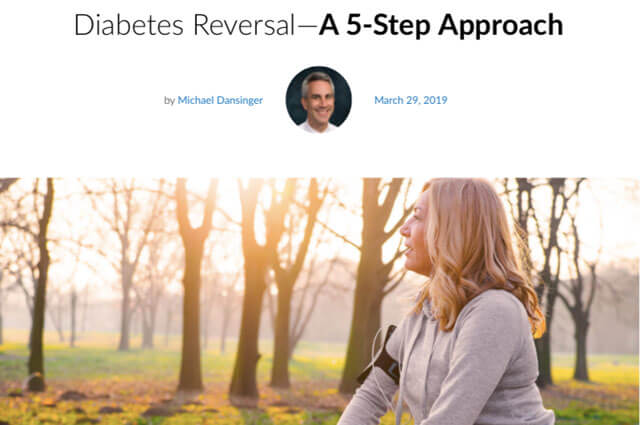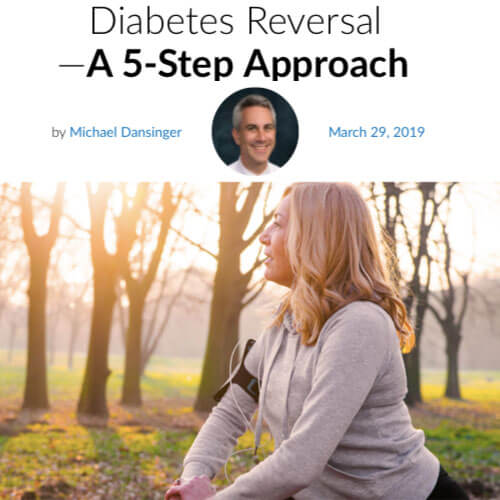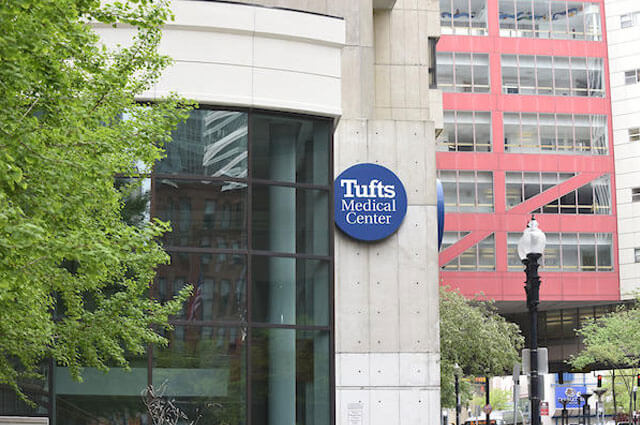DIABETES REMISSION & REVERSAL
The Science of Diabetes
Reversal & Prevention
How To Reverse
Type 2 Diabetes
Diabetes Reversal Program
at Tufts Medical Center

Diabetes is a medical condition where the blood sugar (glucose) level is too high. In the U.S. it affects 12% of adults, including 25% of those over age 65 years. Diabetes rates have skyrocketed during the past 60 years. Many years of high blood sugar from diabetes can cause serious medical complications including premature heart disease, strokes, and damage to eyes, nerves, and kidneys. Diabetes triples the risk of cardiovascular disease and is the leading cause of blindness, foot amputation, and kidney dialysis in the U.S.
Diabetes happens when the beta cells (which live in the pancreas organ and control blood sugar levels) are diseased for some reason. Diseased beta cells can result when the body’s own immune system mistakenly attacks them (type 1 diabetes), or when the beta cells start to wear out from overuse (type 2 diabetes). In adults about 95% of diabetes is type 2.
Type 2 diabetes is so common because of modern dietary habits. Highly processed starchy and sugary foods overstimulate beta cells, especially in people with excess body weight and abdominal fat. After many years of eating unhealthily, the beta cells wear down from overstimulation and can no longer do their job, which is to control blood sugar levels. The obesogenic environment has fueled the epidemics of Type 2 diabetes and obesity.
Unlike type 1 diabetes, type 2 diabetes is definitely preventable. The key to diabetes prevention is achieving a healthy body weight, mainly by consistently following an effective eating strategy.
Yes. “Diabetes reversal” is the process of moving toward diabetes REMISSION, which is normal (or near-normal) blood sugar levels without diabetes medication. Many of my patients have achieved and maintained long-term diabetes remission as a result of lifestyle changes and weight loss using one of many good eating strategies for this purpose. The duration of the diabetes remission depends on the extent and duration of the weight loss.
Weight loss in the 15% range is often enough to achieve remission, or near-remission of type 2 diabetes. For example, individuals who weigh 200 to 250 pounds may be around 30 to 40 pounds away from their “remission weight”. A 20% reduction in calorie intake (for example eating an average of 2000 calories instead of 2500 daily) may be sufficient to achieve this. Any progress in the right direction can help reverse diabetes and reduce the risk of diabetes complications, even if a full remission is not achievable.



How To Reverse Type 2 Diabetes
The information below is from my online article called Diabetes Reversal—A 5-Step Approach:
Type 2 diabetes is one of the world’s most common and serious chronic diseases, so knowing how to reverse it is important. Although there’s no cure, many people have been able to achieve “remission” of type 2 diabetes, meaning their blood sugar levels become normal or nearly normal without diabetes medication. Diabetes reversal is simply the process of getting as close to diabetes remission as possible. Below are 5 steps toward diabetes reversal.
Step 1. Understand what causes type 2 diabetes
Currently, about 12% of the adult population in the United States has diabetes, including about one-fourth of people over age 65 years. The vast majority (around 95%) is type 2 diabetes, which is caused by a series of gradual changes in the body. It often starts with unhealthy dietary habits that take root in childhood and extend into adulthood. Physical activity can’t entirely offset the health consequences of too much unhealthy food, which eventually results in excess body fat inside the abdomen, organs and muscle tissue. This leads to “insulin resistance”, meaning the hormone insulin is less effective than it should be. Insulin is a hormone made by the beta cells of the pancreas organ, which is necessary for cells and tissues to get sugar from the blood for energy.
In people with insulin resistance, the pancreas often has to make double, triple, or quadruple the amount of insulin that would otherwise be needed by the body! After many years of excess insulin production, the insulin-producing cells of the pancreas appear to gradually wear out, stop working properly, and slowly die off. If the pancreas cannot make enough insulin, the sugar levels in the blood get too high. High blood sugar levels cause even more damage to the insulin-producing cells, leading to a vicious cycle of progressive worsening of type 2 diabetes. This can lead to complications of diabetes including premature death from heart disease and other causes. Pills and/or insulin shots are often used to improve the blood sugar levels and reduce the risk of complications, but medications do not reverse the underlying problems that cause type 2 diabetes.
Step 2. Understand what reverses type 2 diabetes
Diabetes reversal always involves making favorable dietary changes. Doing so means the body requires less insulin, which takes some of the strain off the overworked pancreas cells. Favorable dietary changes that produce weight loss can reduce insulin resistance, so the body doesn’t require quite so much insulin production. Weight loss often leads to feeling better physically and emotionally, which fuels a favorable cycle toward better health. Feeling better leads to more physical activity and better eating and more weight loss, and so on. Over time, if healthy habits and weight loss are sustained, the damaged pancreas cells may partially heal.
Weight losses in the 15% range are often enough to achieve remission or near-remission of type 2 diabetes. For example, individuals with type 2 diabetes who weigh 200 to 250 pounds may be around 30 to 40 pounds away from their “remission weight”. A 20% reduction in calorie intake (for example eating an average of 2000 calories instead of 2500 daily) may be sufficient to achieve this.
Step 3. Decide to “Go For It” and get support
Many people with type 2 diabetes aren’t aware that the right eating strategy and lifestyle program may produce enough weight loss to achieve remission or near-remission. Bariatric surgery (such as gastric bypass or gastric sleeve surgery) is an alternative diabetes reversal method to achieve the necessary dietary changes and weight loss. Either way, diabetes remission typically requires working with a team of medical professionals and others who can provide a structured approach with guidance, accountability, and feedback.
There’s a big difference between knowing what to do, versus actually following through on a solid plan. Knowing what to do may be as simple as reading this article. However the next step may be the most challenging—deciding wholeheartedly to make it a top priority and taking steps to work with the right team.
Step 4. Define a strategy and follow through
A solid diabetes reversal strategy includes a medical professional plus additional support. Primary care providers can often provide a good strategy, or make some recommendations. There are many healthy eating strategies that produce good results. The key is to follow the plan closely. A good eating strategy finds the right balance—strict enough to work, but flexible enough to actually follow adequately. It’s important to work with a dietitian or with a coaching program that provides dietary guidance, structure, and accountability. It helps to have external encouragement from others—for example when couples follow the same healthy eating strategy together. Programs may include individual encounters and/or group meetings that may take place either in person or remotely by phone or video. Keeping a food and activity log to review with a dietitian is almost always necessary for good results—doing so provides the structure, accountability, and feedback needed to make ongoing progress. The degree of adherence to the program is the key determinant of the degree of progress.
Step 5. Maintain progress and inspire others
Everybody who has successfully reversed their type 2 diabetes has had times when they fell off track. The difference between those who maintain the progress versus those who don’t comes down to getting back on track after every slip. Having someone in place to assist with such episodes can dramatically increase the odds of long-term success. It’s hard to lose weight and keep it off, but it can be done by putting one’s self in the position of being encouraged and accountable. Maintaining progress is a skill set that’s acquired gradually by getting up every time after getting knocked down.
Successful individuals inspire others by serving as a role model. They help themselves by attracting and assisting people who want to learn from their example. Doing so results in a growing network of like-minded people who become stronger together by learning from each other and encouraging one another.

Lifestyle Based Diabetes Reversal Program At Tufts Medical Center
I founded a Lifestyle Program for Diabetes and Weight Loss (in 2006) that I call the “Diabetes Reversal Program” and continue to run. This program is for patients with primary care at Tufts Medical Center who want lifestyle coaching for weight loss and diabetes prevention or reversal.
I really enjoy this work. Every week I have the privilege of working one-on-one with patients to help them transform. It’s a great feeling to see measurable progress toward meaningful health goals including weight loss and blood test improvements. I typically meet with patients weekly for 3 months, then increase the time between visits according what makes sense to both of us. Over time we get to know one another as we take this journey together as a team.
I’m proud of the results my patients achieve. The average weight loss is 10% for those who stay with my program beyond 3 months. This degree of weight loss always improves the diabetes risk substantially according to the hemoglobin A1c blood test for diabetes risk. Approximately one-third of my patients with type 2 diabetes have achieved remission, which I define as a hemoglobin A1c of 6% or less on no diabetes medication. The likelihood of remission is greatest when the diabetes is more recent, the starting A1c is below 7.5% and the weight loss is beyond 12%. Remission typically takes 3 to 12 months, and can last for years. The longer we work together, and the more closely a patient adheres to the program, the better the results.


